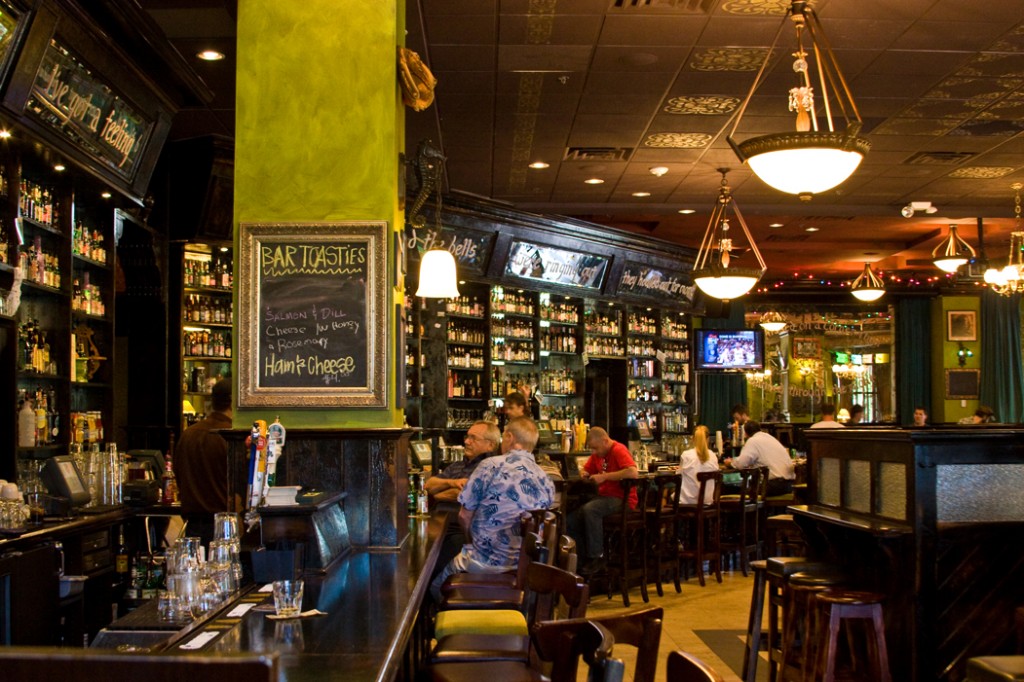
The walls of the bar are covered in old art, photographs of Ireland, and yellowing posters in frames. A pair of hurleys, the flat ash stick of the Gaelic game, are tacked above the door frame. The bar’s otherwise full of dust-coated bottles of bygone whiskeys and stouts, musical instruments, and familiar ridged glass partitions that gracefully generate several spaces where there might have been just one.
Christy Moore, beloved grandfather of contemporary Irish folk music, hums over the speakers. The manager — who, pleasingly, shares a first name with Moore — flits warmly and easily from bar to table, genially, and in a Donegal accent, asking about the general well-being of diners and drinkers. Notably, there are few shamrocks, in any form or medium — they, along with leprechauns, are generally derided as emblematic of a very loose grip on Ireland and “Irishness.”
The Auld Dubliner — small, dark, and convincing, with a flat, matte, unassuming facade (red and yellow lettering over black paint, on wood) — rests between a heavily illuminated branch of T-Mobile and a “dueling piano café” on a street approximately 5,000 miles from the place invoked in its name. Almost every part of the bar the eye falls on — from the stocky tables and the upholstered chairs to the floor tiling and the mock oil lamps dangling from the ceiling — were railed into the unit in Long Beach, California, from a 40-foot container that spent between three and five weeks at sea.
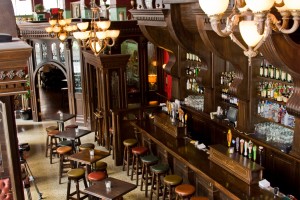 The bar’s trappings belie its location — a retail complex — and the year of its opening: 2003. Like thousands elsewhere, it was designed and prefabricated in Ireland: an export not cultural or theoretical, but actual. The assiduous export and installation of these pre-made Irish bars has been going on for more than 30 years, resulting in a global network of establishments that are interrelated but unrelated. A loose confederation. A franchise without a name.
The bar’s trappings belie its location — a retail complex — and the year of its opening: 2003. Like thousands elsewhere, it was designed and prefabricated in Ireland: an export not cultural or theoretical, but actual. The assiduous export and installation of these pre-made Irish bars has been going on for more than 30 years, resulting in a global network of establishments that are interrelated but unrelated. A loose confederation. A franchise without a name.
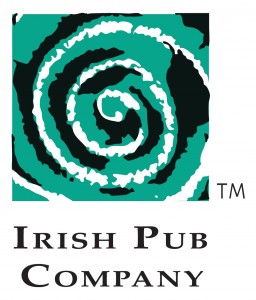 In the late 1970s, Dublin architecture student Mel McNally and some classmates were tasked with analyzing a piece of local architecture. They decided to make their subject the city’s pubs. A dim view was taken of their proposal, but in the end, the project was such a success that it became a months-long public exhibition. Much of the work went missing in the final days, as McNally tells it, so emotive and sought-after were the drawings and renderings.
In the late 1970s, Dublin architecture student Mel McNally and some classmates were tasked with analyzing a piece of local architecture. They decided to make their subject the city’s pubs. A dim view was taken of their proposal, but in the end, the project was such a success that it became a months-long public exhibition. Much of the work went missing in the final days, as McNally tells it, so emotive and sought-after were the drawings and renderings.
McNally went on to research the whole of Ireland to establish a definitive playbook of pub varieties, which led to the foundation of a design and manufacturing specialist, the Irish Pub Company [IPC], in 1990. The ambition was to design and build complete interiors of pubs, first domestically, but then for foreign markets, assembling huge shipments of flooring, decorative glass, mirrors, ceiling tiles, light fixtures, furniture, signage, and bric-a-brac, as well as the obvious centerpiece: the bar itself.
The group now sells bars in six “styles” that can be selected from a company catalog: Shop, Gastro, Victorian, Brewery, Country, and Celtic. At a glance, the variations may seem slight. Upon closer inspection, though, the Victorian option makes distinctively liberal use of brass accents and plummy tones. “Country” is a simpler affair: woody, closer to a kitchen, and liable to feature wall-mounted crockery and/or an open fire. “Modern” would appear to be the hipster iteration, the furniture sleek and the setting more contemporary, one conducive to nu-Irish pursuits like craft beer and artisanal gin tasting.
The companies promoted the flatpack Irish bar, made to order, as a marketable commodity.
The Celtic style, on the other hand, plays up ancient folklore and mythology. “Brewery” uses related paraphernalia, cobblestone, and slate to get at the historical version of its name. “Shop” riffs on the rural pubs that doubled as general stores — or the general stores that doubled as pubs — a special configuration still found in Ireland.
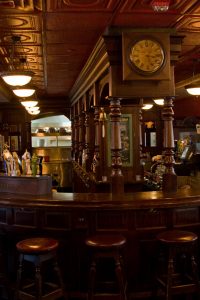 Asked about essential components of an Irish bar, McNally offers, “I think everybody recognizes that good stained glass makes a difference,” delivering the line with total solemnity. Also important: spaces. “When I talk about spaces in pubs, very few clients know what I’m talking about,” he says, naming Dublin’s the Long Hall — a revered, beguiling Dublin pub, popular and relied upon for generations — as emblematic. Part of a protected structure, the pub has a jaunty red exterior and is a deep red within, like a heart, warm and compact, with chambers that inform the natural flow of patrons. “You know when you walk in how you wind up gathering up with people.”
Asked about essential components of an Irish bar, McNally offers, “I think everybody recognizes that good stained glass makes a difference,” delivering the line with total solemnity. Also important: spaces. “When I talk about spaces in pubs, very few clients know what I’m talking about,” he says, naming Dublin’s the Long Hall — a revered, beguiling Dublin pub, popular and relied upon for generations — as emblematic. Part of a protected structure, the pub has a jaunty red exterior and is a deep red within, like a heart, warm and compact, with chambers that inform the natural flow of patrons. “You know when you walk in how you wind up gathering up with people.”
The brewery behind Guinness, faced with flagging sales internationally, partnered with IPC shortly after its 1990 launch. McNally’s model was a highly effective conduit for sales of stout, and financial backing offered by Guinness enabled McNally’s expansion into continental Europe by subsidizing new operators and investing heavily in marketing.
The companies worked together to promote the flatpack Irish bar, made to order, as a marketable commodity. Introductory workshops were hosted. Country managers were appointed to handle particularly interested markets. Later on, assistance reportedly took the shape of a five-day class on all operational aspects and extended to the recruitment of Irish people to staff new openings.
The first two bars to be exported were bound for Berlin, and an order for the makings of a bar in Estonia followed. McNally loses track after that. “In the first five to seven years, I was on a plane every other day of the week,” he says. McNally’s first U.S. opening, in Atlanta, Georgia, in 1996, comprised five styles in one.
Guinness, which eventually had partnered with several companies like IPC, gave up on the bar-marketing program after becoming part of Diageo in the late 1990s. The arrangement had latterly begun to irk incumbent Irish bar owners in locations moved on by the companies, who complained that the coddling of new arrivals by the beverage giant was anticompetitive. A group of Philadelphia pubs boycotted Guinness for this reason in 2001.
McNally is a formalist, and everything he manufactures and sells is Irish-made.
IPC carried on. More than 500 bars and 27 years later, it continues to ship the makings of the Irish bar as far afield as Russia and Kazakhstan. According to McNally, Switzerland has been unexpectedly demanding of late. Before Christmas he installed a bar in Halifax, Nova Scotia.
McNally, the effective grandfather of the movement, is a formalist, and everything he manufactures and sells is Irish-made. Wood and other materials are sourced from an array of indigenous suppliers and fashioned into custom-built bars and fixtures at IPC workshops. This happens to be true of most peers in the space. “I don’t consider them a competitor if they don’t do that,” he says flatly.
On top of his insistence upon use of materials derived exclusively from Ireland, McNally tends to resist anything locally sourced. In China, some of his clients were adamant about the use of their own suppliers and builders. McNally says it led his colleagues to pull their hair out, but they eventually relented. The results can be mixed. On one occasion, McNally provided a drawing for a decorative table fashioned out of a barrel. The client in question, having elected to go some of the way alone, whittled a tree into a solid barrel. The story makes him laugh.
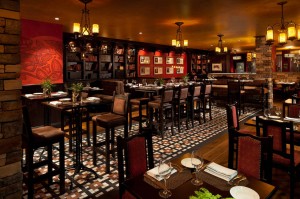 Inside the Auld Dubliner, one might be in a pub in Ireland but for a handful of minor giveaways. A digital clock above the bar counts the seconds to St Patrick’s Day. A sign at the entrance urges people to seat themselves, something that simply does not need saying in Ireland. The bar menu contains a brief glossary of terms. “Chips” are fries, “crisps” are chips, a “rasher” is a piece of bacon, and so on.
Inside the Auld Dubliner, one might be in a pub in Ireland but for a handful of minor giveaways. A digital clock above the bar counts the seconds to St Patrick’s Day. A sign at the entrance urges people to seat themselves, something that simply does not need saying in Ireland. The bar menu contains a brief glossary of terms. “Chips” are fries, “crisps” are chips, a “rasher” is a piece of bacon, and so on.
The bar is a product of ÓL Irish Pubs (pronounced “ole”, the Irish verb to drink), another Dublin-based Irish bar designer and manufacturer. ÓL has installed bars in places like Oman, New Zealand, and India, as well as on cruise liners and in private homes. Within a period of 16 weeks after the designs are approved, John Heverin and his team build, ship, and install every component of the bar, handing the keys to the owner once complete.
Some first-timers are “a bit romantic about it,” says Heverin, an ÓL co-founder. The pub that goes into a ski resort is different than what goes into New York City is different than what goes into a university town, and he says expectations have to be delicately managed. “Can a client justify the cost of the fit-out where two pints of Budweiser is the go-to order?” he asks.
According to Heverin, food is now near-singlehandedly “winching” the Irish bar from the past. Every shopfront his company builds now is suffixed with “and restaurant,” whereas previously, what Heverin calls “basket food” was long sufficient, unquestioned fare: An Irish name would often be appended to an otherwise trite bar food item (normally, it may be worth noting, one not readily available in Ireland until the mid-aughts, if at all, like chicken wings, mozzarella sticks, or tater tots).
Although beer batter continues to encase many popular bar snacks, the menus of new pubs exhibit increasingly aspirational impulses. Heverin points to the Stag’s Head in Dublin as a leading indicator. On a given day, it can offer white bean hummus, chili with gorgonzola, or vegan tartare. McNally, for his part, also alludes to the appeal and potential of “small plates” or, as he calls them, “Irish tapas.” Here and there, you can find evidence of this philosophy, which, leaning on creative treatment of Kerrygold cheddar, smoked salmon, and black pudding, borrows nothing from Spain but the moniker.
Courtesy of Irish Pub Company
Bar design and manufacturing companies don’t typically weigh in on culinary matters, but ÓL does, and IPC has in the past worked with a Toronto-based consultancy, Ballance Hospitality, which offers menu development for Irish bars as one of its services. Donal Ballance, its founder, urges clients to “revert to the mothership” by communicating with the Irish food board and staying abreast of ingredient availability. A ban on Irish beef in the U.S., for example, was lifted in 2015.
Ballance is involved in the opening of between six and 10 Irish bars a year, mostly in the U.S. His informational website has taken in official queries from 164 countries in two years, and the form is detailed. According to Ballance, the Dead Rabbit and Ulysses, both in Manhattan, exemplify “Irish pub 2.0.” Independently established, the bars contrive to an elevated version of the form, the former being “an Irish bar that redefined hospitality,” in its own words. Often, 2.0 can mean oysters and herb sprigs adorning cocktails in crystal tumblers.
All bars can have a go of this, though — the Auld Dubliner in Long Beach offers a drink called the Dublin Donkey: a blend of whiskey, honey liqueur, and ginger beer in a copper mug — a mug that requires a deposit of a driver’s license or $20. Upward reinvention and adaptation of this sort is rife, if occasionally clumsy, but it appears to be working out.
“People walk through that front door with a certain expectation connecting to Ireland and to the Irish.”
But, according to Ballance, there’s a growing awareness that an Irish bar built “in three days with materials from Home Depot,” once it has the right operator and the right spirit (and even if plastered in top-o’-the-mornin’ imagery), can go toe-to-toe with any of those pubs that are painstakingly and lovingly assembled, at a multiple of the cost, with the help of companies like his, McNally’s, or Heverin’s.
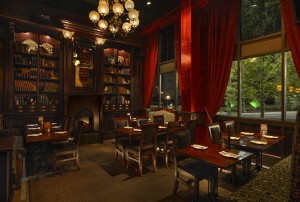 What, then, motivates people to continue investing in the outsourced construction of the Irish bar? A desire for an authenticity, demonstrably, but not the kind that is expressly promoted. The fact that a bar was built by a team of carpenters in the Irish midlands is a detail that tends to go unwritten: Customers generally aren’t made aware of the provenance of different elements of the bar. It would seem that the achieving an overall sense of Ireland generated by the constituent parts is the priority, and is in itself enough.
What, then, motivates people to continue investing in the outsourced construction of the Irish bar? A desire for an authenticity, demonstrably, but not the kind that is expressly promoted. The fact that a bar was built by a team of carpenters in the Irish midlands is a detail that tends to go unwritten: Customers generally aren’t made aware of the provenance of different elements of the bar. It would seem that the achieving an overall sense of Ireland generated by the constituent parts is the priority, and is in itself enough.
Ballance is outspoken in his promotion and defense of the business, bringing to my attention an eight-year-old Irish Times article that sounded the death knell for what it termed the “McPub.” “It’s great that lots of people in the world still believe that a couple of pints, a chat, and a friendly welcome is a very desirable Irish characteristic and not some weird anachronism,” he says, expanding on a closely held belief in the Irish bar’s objective virtues as a place. In his estimation, it’s the key to its resilience.
“Do I see [the Irish bar] falling over a cliff? No, I really don’t,” Heverin says. “People walk through that front door with a certain expectation connecting to Ireland and to the Irish. Unless we somehow change status in the world,” he says, audibly smiling, “I think we’ll be fine.”
In Ireland, the Irish bar is known only as the pub. Those in the business of fashioning and transposing it onto foreign parts are concerned with its accurate replication, facilitating a singular ambiance and atmosphere, both special and real, whatever the designation. Throughout my conversation with McNally, I toggled between two terms in my mind, but, knowing my audience, stuck to one. Shortly after he raised the Long Hall as an archetype to look up to, I slipped up.
“Just now you said ‘bar’,” McNally said. “It’s a pub.”
Articles
Some of the most unusual places to find one or more Irish Pubs are Baku in Azerbaijan, Ulaanbaatar in Mongolia, Gili Trawangan in Indonesia and Ushuaia in the most southerly tip of Tierra del Fuego.